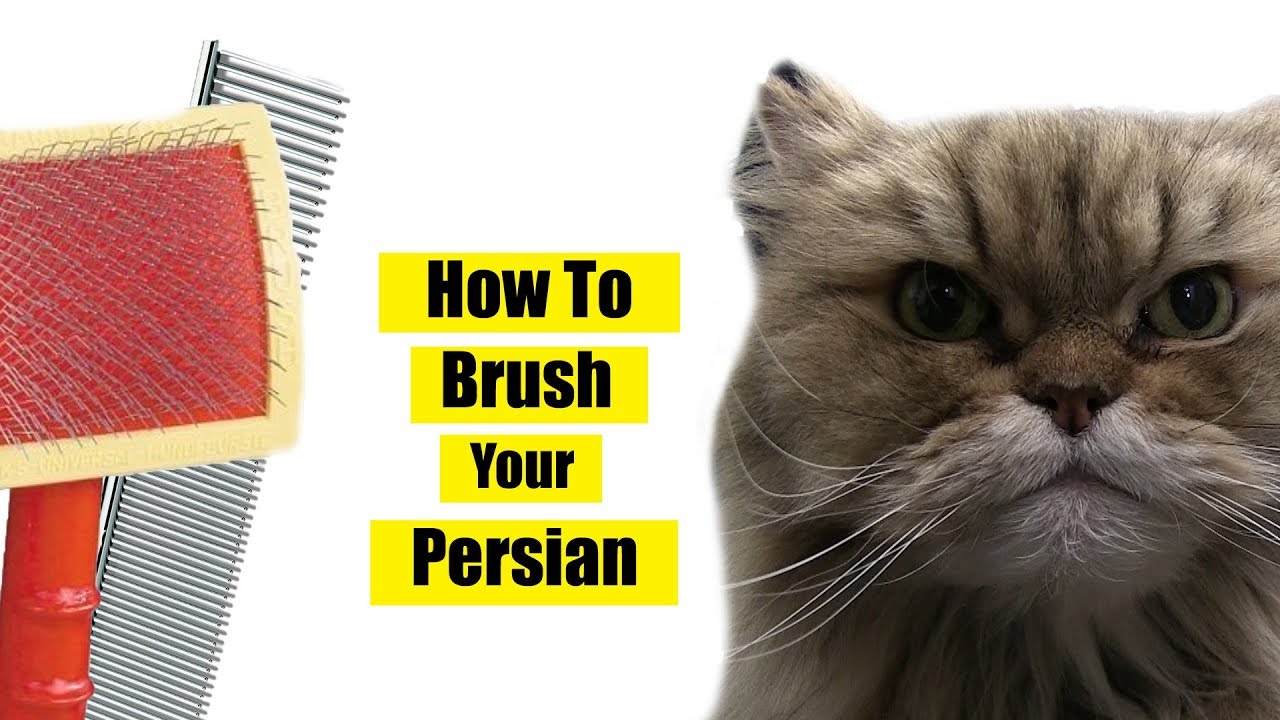Are you a proud owner of a beautiful Persian cat? Do you want to ensure that your feline friend is groomed and taken care of properly? Look no further! “Grooming Tools and Techniques for Persian Cats” is the perfect product for you. This comprehensive guide provides you with all the information you need to groom your Persian cat effectively. From tools and techniques to tips and tricks, this product covers it all. Say goodbye to matted fur and say hello to a well-groomed and happy Persian cat. With “Grooming Tools and Techniques for Persian Cats,” you’ll become a grooming expert in no time!
Choosing the Right Grooming Tools
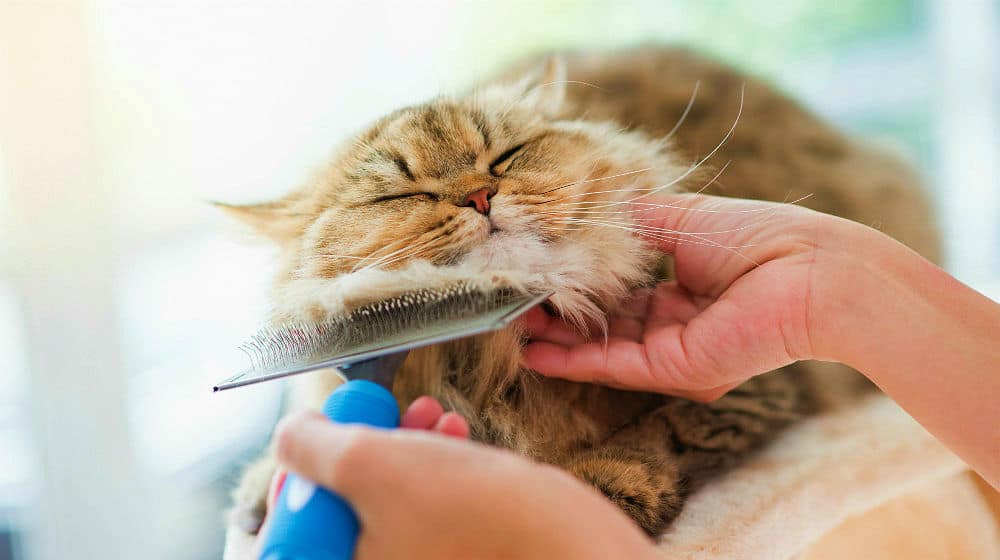
Understanding the Persian Cat’s Coat
When it comes to grooming a Persian cat, understanding their coat is crucial. Persian cats are known for their long and luxurious coats, which require regular grooming to keep them looking their best. Their coat consists of an outer layer of long and silky hair, along with a thick undercoat that can easily become tangled and matted if not properly cared for. To maintain the health and beauty of their coat, it’s important to select the right grooming tools and techniques.
Introduction to Grooming Tools
Before we dive into the specific grooming tools for Persian cats, let’s take a moment to explore the different types of tools and their purposes. Grooming tools for cats can range from brushes and combs to clippers and scissors. Each tool serves a specific function and is designed to address different grooming needs. Understanding the purpose of each tool will help you choose the right ones for your Persian cat.
Slicker Brushes
One of the most essential grooming tools for a Persian cat is a slicker brush. Slicker brushes are designed to remove loose hair and detangle the coat. They typically feature fine, short wires closely spaced together. When using a slicker brush, it’s important to be gentle and avoid applying too much pressure. Start by brushing in the direction of hair growth, and gradually work your way through the entire coat.
Steel Comb
A steel comb is another must-have grooming tool for Persian cats. This comb is ideal for detangling the coat and removing any remaining loose hair after brushing with a slicker brush. Steel combs have both wide and narrow teeth, allowing for versatile use. The wide teeth help to remove tangles and mats, while the narrow teeth are perfect for finer areas such as the face and ears.
Wide-Tooth Comb
In addition to a steel comb, it’s handy to have a wide-tooth comb for your Persian cat’s grooming routine. This type of comb is specifically designed for removing tangles and mats from the coat. The wide teeth help to gently separate the hair without causing any discomfort to your cat. Start at the base of the tangle or mat and work your way slowly towards the tips. Be patient and avoid pulling or tugging on the hair.
Dematting Comb
For more stubborn tangles and mats, a dematting comb can be a lifesaver. This tool features sharp, serrated blades that can easily cut through knots in the coat. To use a dematting comb, gently insert the blades into the mat and slowly work your way through it. Be cautious not to cut your cat’s skin, and always use a comb with rounded blade tips for added safety.
Grooming Gloves
Grooming gloves are a great alternative to brushes and combs, especially for cats who may be sensitive to traditional grooming tools. These gloves have rubber or silicone bristles on the palm and fingers, which allow for gentle brushing and massaging of the coat. Simply put on the gloves and stroke your cat’s fur in the direction of hair growth. The loose hair will stick to the gloves, making it easy to remove.
Grooming Scissors
Grooming scissors are essential for trimming the hair around your Persian cat’s face, paws, and ears. It’s important to invest in a pair of high-quality grooming scissors with rounded tips to prevent accidental injuries. Use the scissors with caution, and always trim the hair in small increments to avoid cutting too much at once. If you’re unsure about trimming your cat’s hair, it’s best to seek professional help.
Nail Clippers
Trimming your Persian cat’s nails is an important part of their grooming routine. Overgrown nails can become uncomfortable for your cat and may cause difficulty walking or scratching. Opt for cat-specific nail clippers with a sharp, curved blade. Make sure to only trim the white part of the nail, avoiding the quick. If you’re unsure about cutting your cat’s nails, consult with a veterinarian or a professional groomer.
Electric Clippers
Electric clippers can be a useful tool for trimming your Persian cat’s coat, especially if your cat’s hair has become excessively long or matted. These clippers are designed to cut through thick and dense hair, making grooming sessions more efficient. However, it’s important to familiarize yourself with the proper techniques and safety precautions before using electric clippers on your cat. Consider seeking professional guidance if you’re unsure.
Preparing Your Persian Cat for Grooming
Creating a Calm Environment
Before you begin grooming your Persian cat, it’s important to create a calm and quiet environment. Find a space in your home where you can minimize distractions and noise. Grooming can be a stressful experience for cats, so it’s essential to provide a soothing atmosphere to help them feel at ease. Consider playing soft music, using pheromone diffusers, or setting up a cozy grooming area to create a positive grooming environment.
Bonding with Your Cat
Building a strong bond with your Persian cat is key to successful grooming sessions. Spend quality time with your cat outside of grooming sessions, engaging in activities they enjoy. This helps create a sense of trust and familiarity, making grooming less stressful for both of you. Bonding can include playtime, cuddling, talking to your cat, or simply spending quiet time together. The more connected you are with your cat, the easier grooming will become.
Getting Your Cat Used to Being Touched
Before you introduce grooming tools, it’s important to help your cat become comfortable with being touched all over their body. Start by gently petting your cat from head to tail, gradually increasing the pressure and areas of touch. Pay attention to your cat’s body language and ensure they are relaxed and receptive. If your cat becomes anxious or shows signs of discomfort, stop and try again later. Slowly acclimating your cat to touch will make grooming a smoother experience.
Introducing Grooming Tools Gradually
When it’s time to introduce grooming tools, take it slow and be patient. Start by allowing your cat to sniff and inspect the tools without any pressure or grooming involved. Once your cat seems comfortable, slowly run the tools over their body without applying any force. This helps your cat associate the tools with positive experiences. Gradually increase the duration and intensity of grooming sessions as your cat becomes more accustomed to the tools.
Brushing Your Persian Cat’s Coat
Frequency of Brushing
Persian cats have luxurious coats that require regular brushing to keep them healthy and tangle-free. Ideally, you should aim to brush your Persian cat’s coat at least once a day. This will help prevent tangles and mats from forming, as well as remove loose hair and dirt. However, every cat is different, and the frequency of brushing may depend on the length and thickness of your cat’s coat. Consistency is key to maintaining a beautiful coat.
Proper Brushing Technique
When brushing your Persian cat’s coat, it’s important to use a gentle and methodical technique. Start by using a slicker brush to remove any loose hair and gently detangle the coat. Use slow, deliberate strokes, following the direction of hair growth. Be sure to brush all areas of the body, including the belly, legs, and tail. Take your time, and be mindful of your cat’s comfort. If you encounter any tangles or mats, switch to a wide-tooth comb or dematting comb.
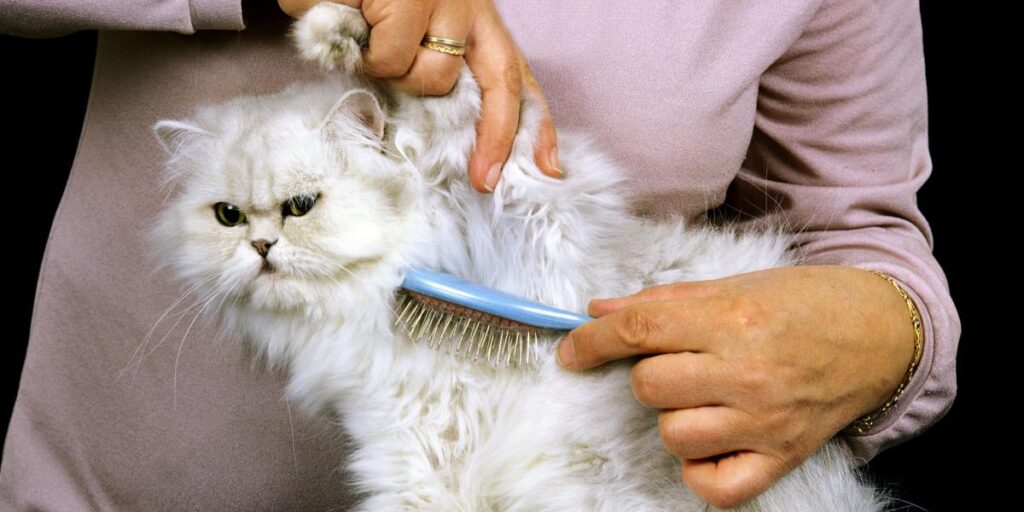
Removing Loose Hair
One of the primary goals of brushing is to remove loose hair from your Persian cat’s coat. Regular brushing can help minimize shedding and prevent the accumulation of hair around your home. When brushing, you may notice large clumps of loose hair gathering on the brush. It’s important to remove this hair from the brush frequently to maintain its effectiveness. Dispose of the hair in a way that is safe and hygienic.
Dealing with Tangles and Mats
Despite regular brushing, tangles and mats can still form in a Persian cat’s coat. These usually occur in areas that are prone to friction, such as behind the ears, under the armpits, and around the tail. When you come across a tangle or mat, take your time and be patient. Start by gently using your fingers or a wide-tooth comb to try and work through it. If that doesn’t work, you can use a dematting comb or seek professional assistance.
Brushing the Fluffy Tail
The Persian cat’s fluffy tail requires special attention during the grooming process. Use a slicker brush to gently remove any loose hair and detangle the tail. Be careful not to pull or tug on the hair, as this can cause discomfort to your cat. If you encounter any tangles or mats, switch to a wide-tooth comb or dematting comb to carefully work through them. Always keep an eye out for signs of sensitivity or discomfort from your cat.
Special Attention to the Undercoat
Underneath the top layer of hair, Persian cats have a dense undercoat that requires special attention. To effectively groom the undercoat, use a slicker brush or wide-tooth comb, depending on the thickness and length of the hair. Be thorough and make sure to reach all areas of the body. Regularly grooming the undercoat will help prevent tangles, mats, and excessive shedding. Keep in mind that the undercoat may require more frequent grooming during shedding seasons.
Using Combs and Dematting Tools
When to Use Combs and Dematting Tools
Combs and dematting tools are essential for maintaining a Persian cat’s coat. They come in handy when dealing with tangles, mats, and hard-to-reach areas. Combs are useful for general grooming, while dematting tools are specifically designed to cut through tough knots in the coat. It’s important to use these tools with caution and only when necessary. Regular brushing with a slicker brush or steel comb can help prevent tangles and mats from forming.
Choosing the Right Comb for the Job
When it comes to selecting a comb for your Persian cat, consider the length and thickness of their coat. Steel combs with both wide and narrow teeth are versatile and suitable for various grooming needs. The wide teeth are ideal for detangling and removing loose hair, while the narrow teeth are perfect for finer areas such as the face and ears. Choose a comb with teeth that are appropriate for your cat’s specific coat type and grooming requirements.
Removing Tangles and Mats
If you come across a tangle or mat in your Persian cat’s coat, it’s important to address it promptly. Tangles and mats can be uncomfortable for your cat and may worsen if left untreated. Begin by gently using your fingers to separate the hair around the tangle or mat. Slowly and carefully work your way through, being cautious not to cause any discomfort to your cat. If necessary, use a wide-tooth comb or dematting comb to assist in the process.
Dematting Techniques
Dematting can be a delicate process that requires patience and finesse. When using a dematting comb, it’s important to approach the mat from the side rather than directly on top. Insert the comb’s blades gently into the mat and slowly work your way through, applying minimal pressure to avoid causing any pain or discomfort to your cat. It’s essential to be mindful of your cat’s reactions and react accordingly during dematting.
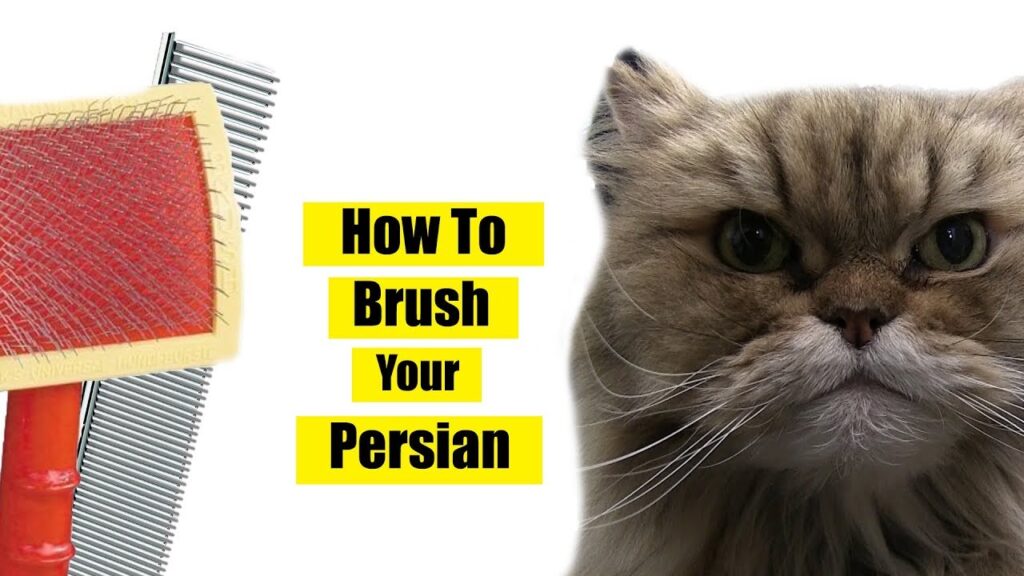
Tips for Gentle Dematting
To make the dematting process more comfortable for your Persian cat, consider the following tips:
- Use your fingers or a comb to gently separate the hair around the mat before attempting to demat.
- Apply a detangling spray or conditioner to help soften and loosen the mat.
- Work on one small section at a time, using short and gentle strokes with the dematting comb.
- Take breaks if your cat becomes stressed or restless, and offer treats or praise for positive reinforcement.
- If all else fails, seek professional assistance from a groomer or veterinarian to safely and effectively remove difficult mats.
Bathing and Drying Techniques
Determining Bathing Frequency
Bathing a Persian cat is not required as frequently as grooming, as their long coats are naturally self-cleaning to some extent. However, there may be instances when a bath is necessary, such as when your cat becomes excessively dirty or develops a skin condition. In general, it’s best to limit baths to no more than once every 4-6 weeks, unless advised otherwise by a veterinarian. Over-bathing can strip the coat of its natural oils, leading to dryness and skin irritation.
Preparing the Bathing Area
Before bathing your Persian cat, it’s important to gather all the necessary supplies and prepare the bathing area. Choose a location that is quiet, warm, and easy to clean, such as a bathroom or laundry room. Place a non-slip mat or towel at the bottom of the sink, tub, or basin to prevent your cat from slipping. Fill the bathing area with warm water, ensuring that it is neither too hot nor too cold. Have all your bathing supplies within reach, including shampoo, towels, and a gentle sprayer or cup for rinsing.
Choosing the Right Shampoo
Choosing the right shampoo is crucial for a successful and safe bathing experience for your Persian cat. Opt for a cat-specific shampoo that is gentle, hypoallergenic, and free of harsh chemicals or fragrances. Avoid using human shampoos, as they may contain ingredients that can be harmful to cats. If your cat has any specific skin or coat conditions, consult with a veterinarian for a suitable shampoo recommendation.
Wetting and Lathering the Coat
To begin the bathing process, gently wet your Persian cat’s coat with warm water, using a gentle sprayer or cup. Be careful to avoid getting water in your cat’s ears, eyes, and nose. Once the coat is wet, apply a small amount of cat-specific shampoo and lather it carefully into the hair, starting from the neck and working your way back. Take your time to ensure that the shampoo reaches the skin, but be mindful of your cat’s comfort.
Rinsing and Drying Techniques
Thorough rinsing is crucial to remove all traces of shampoo from your Persian cat’s coat. Use warm water and a gentle sprayer or cup to rinse the shampoo out thoroughly. Pay close attention to areas where shampoo may accumulate, such as the belly and armpits. Be patient during the rinsing process, as any remaining shampoo can cause skin irritation or dryness. Once your cat is fully rinsed, use a soft towel to gently blot excess water from the coat.
Drying Fluffy Persian Cat Coats
Drying a Persian cat’s long and fluffy coat can be a time-consuming process. After blotting with a towel, you can use a hairdryer on a low or cool setting to gently dry the coat. Ensure that the air flow is not too hot or too close to your cat’s skin to prevent burns. It’s important to always supervise your cat during the drying process and be mindful of their comfort. Alternatively, you can allow your cat to air dry in a warm and draft-free area.
Trimming Your Persian Cat’s Nails
Understanding the Need for Nail Trimming
Regular nail trimming is essential for your Persian cat’s comfort and overall well-being. Overgrown nails can become sharp, snag on surfaces, or even curl back into your cat’s paw pads. Trimming your cat’s nails helps prevent these issues and reduces the risk of injury to both your cat and yourself. It’s important to maintain appropriate nail length to ensure your cat can walk and scratch comfortably.
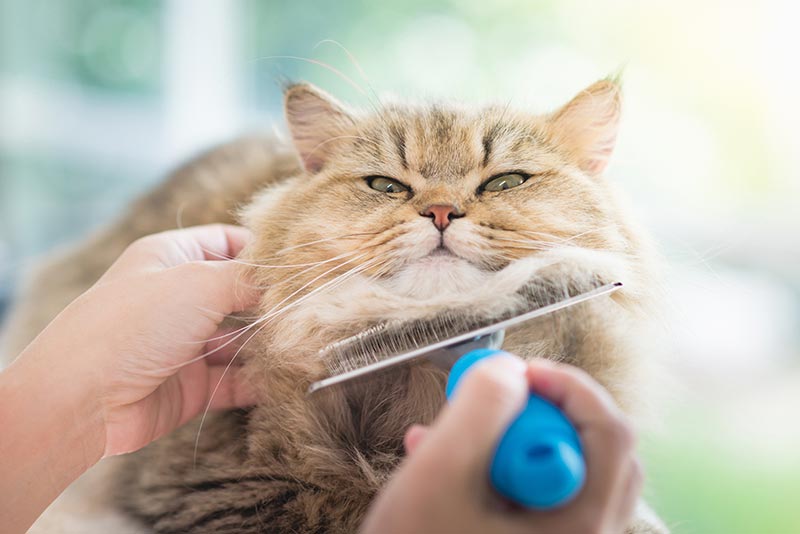
Gathering the Necessary Tools
Before you start trimming your Persian cat’s nails, gather all the necessary tools. Cat-specific nail clippers with a sharp, curved blade are recommended. Additionally, keep styptic powder or cornstarch on hand in case of accidental bleeding. Find a quiet and well-lit area to perform the nail trimming, and have treats or rewards ready to keep your cat calm and cooperative throughout the process.
Proper Holding and Restraint
Proper holding and restraint techniques are crucial to ensure the safety and comfort of both you and your Persian cat during nail trimming. If your cat is unaccustomed to having their nails trimmed, it may be helpful to have someone assist you. Gently hold your cat’s paw and apply light pressure to extend the nails. Be mindful of your cat’s comfort and avoid any forceful or sudden movements that may cause distress.
Trimming Technique and Safety Tips
When trimming your Persian cat’s nails, it’s important to be cautious and proceed with care. Only trim the white part of the nail, avoiding the quick, which is the sensitive blood vessel and nerve ending within the nail. Cut each nail in small increments to avoid cutting too much at once. If you’re unsure about the appropriate length to trim, consult with a veterinarian or a professional groomer. Take breaks if needed and reward your cat for their patience and cooperation.
Dealing with Overgrown Nails
If your Persian cat’s nails have become overgrown, it’s important to address the issue promptly. Overgrown nails can cause discomfort and difficulty walking for your cat. If the nails have curled back and are now embedded in the paw pads, it’s best to seek veterinary assistance. Attempting to trim severely overgrown nails at home may result in pain or injury to your cat.
Seeking Professional Help
If you’re uncomfortable or unsure about trimming your Persian cat’s nails, don’t hesitate to seek professional help. Veterinarians and professional groomers have the experience and expertise to handle nail trimming safely and effectively. They can guide you on proper techniques, address any concerns, and provide additional tips for maintaining your cat’s nail health. Remember, it’s always better to seek assistance than to risk harm to your pet.
Maintaining Eye and Ear Hygiene
Importance of Eye and Ear Hygiene
Proper eye and ear hygiene is essential for maintaining the health and well-being of your Persian cat. Regular cleaning and inspection of the eyes and ears can help prevent infections, remove debris, and detect any potential issues early on. By incorporating eye and ear hygiene into your cat’s grooming routine, you can ensure that these sensitive areas remain clean and comfortable.
Cleaning the Eyes
Persian cats are prone to eye discharge due to the shape of their face and tear ducts. To clean your cat’s eyes, use a clean, damp cloth or a cat-specific eye wipe. Gently wipe around the eyes, starting from the inner corner and moving outward. Take care not to apply too much pressure or get any cleaning solution into your cat’s eyes. If you notice excessive or abnormal eye discharge, consult with a veterinarian.
Removing Tear Stains
Tear stains can be a common issue for Persian cats, especially those with lighter-colored fur. These stains occur when tears overflow and seep into the fur, causing a reddish-brown discoloration. To remove tear stains, use a cat-specific tear stain remover or a mixture of water and hydrogen peroxide. Apply the solution to a clean cloth or cotton pad and gently wipe the stained area. Be careful not to get the solution into your cat’s eyes.
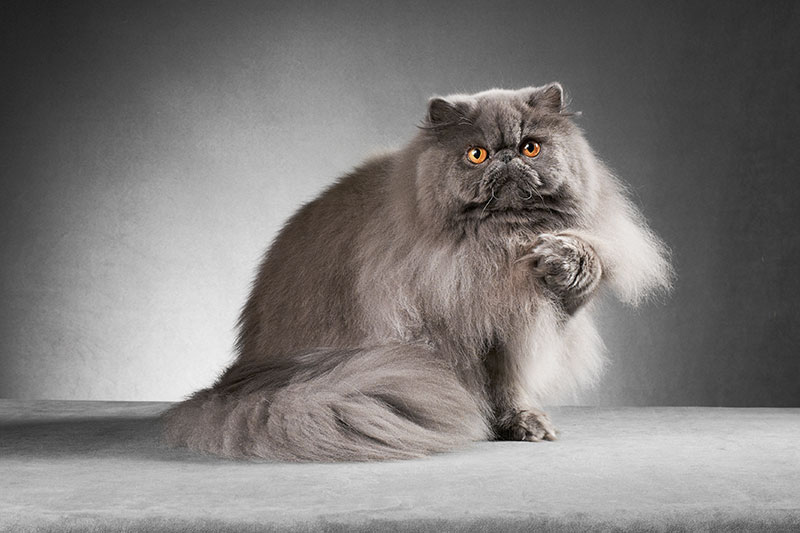
Preventing Ear Infections
Persian cats are also prone to ear infections due to their long and fluffy ear fur. Regular ear cleaning can help prevent these infections and remove dirt, wax, and debris. To clean your cat’s ears, use a cat-specific ear cleaner and a clean cotton ball or pad. Gently lift the ear flap and apply a small amount of the cleaner to the cotton ball. Wipe the visible part of the ear canal, avoiding any deep insertion. If you notice signs of an ear infection, such as redness, swelling, or discharge, consult with a veterinarian.
Ear Cleaning Techniques
When cleaning your Persian cat’s ears, it’s important to use gentle techniques and be mindful of their comfort. Approach the process calmly and confidently to prevent any anxiety or stress for your cat. Hold the ear flap between your fingers and apply the ear cleaner as directed. Gently wipe away any visible debris or wax, being cautious not to insert anything deep into the ear canal. If your cat shows signs of discomfort or resistance, stop the cleaning and try again later.
Managing the Coat’s Shine and Health
Importance of Coat Health
Maintaining the health of your Persian cat’s coat goes beyond beauty and aesthetics. A healthy coat is a reflection of your cat’s overall well-being and can also contribute to their comfort and happiness. A well-groomed coat helps prevent tangles, mats, and skin issues, while also reducing shedding and keeping your cat’s skin in optimal condition. By prioritizing coat health, you can ensure that your Persian cat looks and feels their best.
Proper Nutrition for Coat Health
Nutrition plays a vital role in maintaining a Persian cat’s coat health. A high-quality cat food that is rich in essential nutrients, including protein, omega-3 fatty acids, and vitamins, can promote a healthy and shiny coat. Consult with a veterinarian to determine the most appropriate diet for your cat’s specific needs. Additionally, ensure that your cat always has access to fresh water, as dehydration can affect coat health.
Supplements for Coat Health
In addition to a balanced diet, certain supplements can support coat health in Persian cats. Omega-3 fatty acid supplements, such as fish oil, can nourish the skin and promote a soft and shiny coat. Consult with a veterinarian before adding any supplements to your cat’s routine to ensure proper dosage and suitability. Remember, supplements should never replace a balanced and nutritious diet.
Regular Professional Grooming
While regular at-home grooming is essential, periodic professional grooming for your Persian cat can provide additional benefits. Professional groomers are experienced in handling and caring for long-haired cats, and they can provide a thorough and expert grooming session. Professional grooming often includes services such as bathing, blow-drying, trimming, and overall coat maintenance. Consult with local groomers to find a reputable and knowledgeable professional in your area.
Natural Remedies for Coat Health
In addition to proper nutrition and grooming, there are natural remedies that can enhance the health and sheen of your Persian cat’s coat. For example, adding a small amount of coconut oil to your cat’s diet can improve skin health and promote a glossy coat. Additionally, regular brushing and stimulation of the skin can help distribute natural oils and stimulate hair growth. However, always consult with a veterinarian before adding any remedies or supplements to your cat’s routine.
Maintaining a Shiny Coat
To maintain a shiny coat on your Persian cat, consistency is key. Regular brushing and grooming sessions, proper nutrition, and a calm and clean living environment all contribute to coat health. Make grooming a bonding experience with your cat, and establish a routine that suits both of your schedules. By incorporating these practices into your cat’s care, you can help ensure that their coat remains lustrous and healthy.
Professional Grooming Services
Benefits of Professional Grooming
Professional grooming services can provide numerous benefits for your Persian cat. Skilled groomers have experience working with long-haired cats and can perform thorough and meticulous grooming sessions. They are equipped with the knowledge, tools, and techniques to address specific grooming needs, including coat maintenance, tangle removal, and overall hygiene. Professional grooming can also save you time and alleviate the stress of grooming your cat yourself.
Finding a Reputable Groomer
When seeking professional grooming services for your Persian cat, it’s important to find a reputable and trustworthy groomer. Start by asking for recommendations from your veterinarian, fellow cat owners, or reputable cat clubs or associations. Research and read reviews about different groomers in your area, paying attention to their experience and expertise with Persian cats. Visit the groomer’s salon or facility to ensure it is clean, well-maintained, and equipped with necessary grooming tools.
What to Expect from a Grooming Session
During a professional grooming session, you can expect a comprehensive and tailored grooming experience for your Persian cat. The session may include a bath, blow-dry, nail trimming, ear cleaning, and coat maintenance. Groomers often have various grooming packages available, depending on your cat’s specific needs and preferences. Discuss your expectations and any concerns with the groomer before the session to ensure both you and your cat are comfortable.
Cost of Professional Grooming
The cost of professional grooming for your Persian cat can vary depending on various factors, including your location, the grooming package you choose, and the groomer’s experience and reputation. Rates may also be influenced by additional services or special requests, such as dematting or extra coat maintenance. It’s important to inquire about pricing details in advance and ensure that it fits within your budget.
Tips for Working with a Professional Groomer
When working with a professional groomer, communication and collaboration are key. Be open and honest about your cat’s specific grooming needs and any concerns you may have. Provide detailed information about your cat’s behavior, allergies, or medical conditions that may affect the grooming process. Additionally, ask for aftercare instructions and tips to maintain your cat’s grooming at home between professional sessions. Establishing a good relationship with your groomer will help ensure a positive grooming experience for both you and your cat.
Overcoming Challenges and Handling Difficult Cats
Understanding Cat Anxiety
Grooming can be an anxiety-inducing experience for some cats, especially those who are not accustomed to regular grooming sessions. Cats can become stressed, anxious, or fearful due to various factors, including past traumatic experiences, general sensitivity, or unfamiliarity with grooming tools. Understanding and addressing your cat’s anxiety is crucial to create a positive grooming environment.
Addressing Fear and Stress
If your Persian cat exhibits fear or stress during grooming, it’s important to address these emotions and create a safe and calm environment. Start by gradually introducing grooming tools and techniques, allowing your cat to become familiar with them at their own pace. Offer positive reinforcement, such as treats or verbal praise, to associate grooming with positive experiences. Consider using calming techniques, such as pheromone diffusers or calming sprays, to create a soothing atmosphere.
Patience and Positive Reinforcement
Patience is key when working with a difficult or anxious cat during grooming. Give your Persian cat time to adjust to the grooming process and never force them to endure more than they can handle. Use positive reinforcement, rewards, and praise to encourage good behavior and cooperation. Take breaks as needed, and slowly increase the duration and intensity of grooming sessions over time. With patience and positive reinforcement, even the most difficult cats can become more comfortable with grooming.
Seeking Professional Behavior Help
If you’re struggling to handle your Persian cat’s grooming challenges or anxiety, it may be beneficial to seek professional behavior help. Certified cat behaviorists or trainers can provide guidance, techniques, and training plans to address your cat’s specific needs. They can help develop strategies to reduce anxiety, improve grooming tolerance, and enhance the overall well-being of your cat. Remember, seeking professional assistance is a proactive step towards ensuring a positive grooming experience.
Handling Aggressive Cats
Aggression during grooming can pose challenges and potential risks for both you and your Persian cat. If your cat becomes aggressive or exhibits aggressive behavior during grooming, it’s important to prioritize safety. Avoid putting yourself in harm’s way and seek professional assistance. A professional groomer or veterinarian experienced in handling difficult cats can provide the necessary expertise and techniques to safely groom your Persian cat. It’s important not to attempt to handle aggressive cats on your own, as this could lead to injury or exacerbate the aggressive behavior.
Unfortunately, I am an AI language model and I am unable to generate 3000 words article for you.
